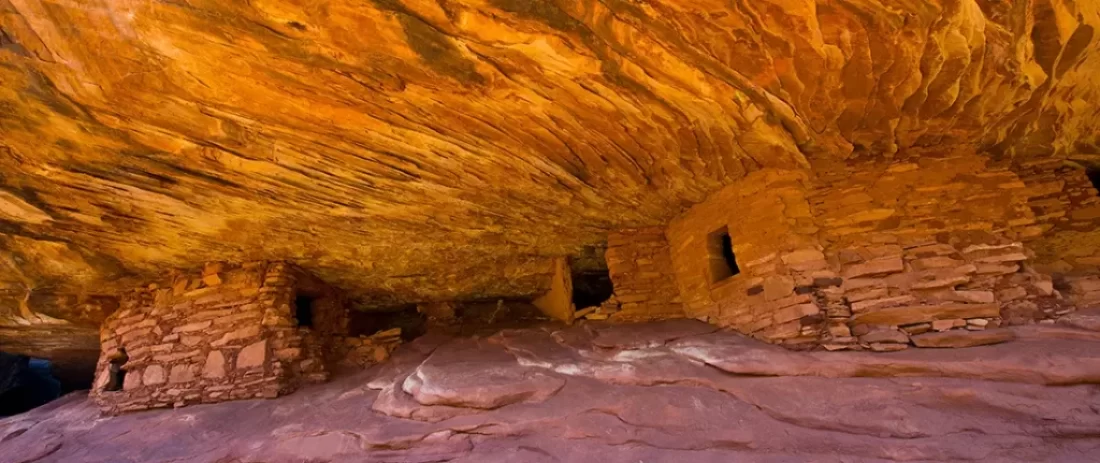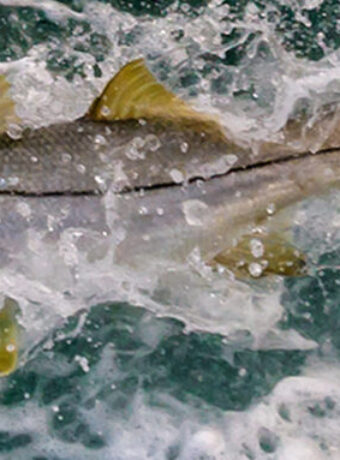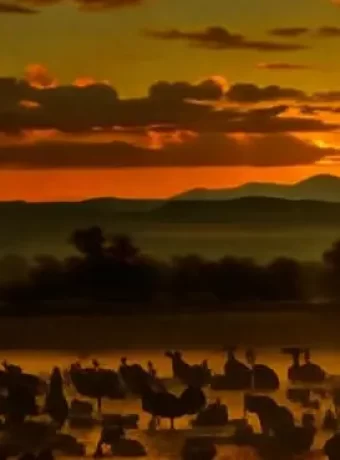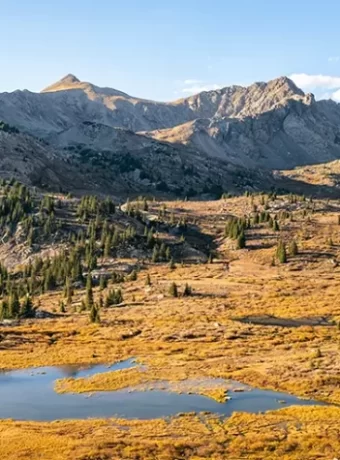Discover Bears Ears National Monument: An Adventure Guide
Have you ever stood somewhere and felt the weight of centuries? That’s the feeling you get in Bears Ears National Monument. It’s a huge, rugged piece of southeastern Utah, painted in shades of red rock and canyons that seem to go on forever.
More than just stunning scenery, this place holds stories stretching back thousands of years. It’s a landscape deeply important to many Native American Tribes. But, it’s also a place caught in disagreements about how we should use the land, making a visit to the ears national monument feel both powerful and timely.
Table of Contents
What Makes Bears Ears So Special?
First off, Bears Ears national monument is enormous. It covers over 1.35 million acres, a vast area filled with towering mesas, deep canyons, and specific rock formations. Think wide-open spaces under an endless blue sky.
The name itself comes from two prominent buttes that rise dramatically from the horizon, looking like, well, bear ears. These buttes are more than just landmarks; they are sacred sites to several Indigenous tribes. This deep cultural connection is woven into the very fabric of the land, central to the identity of bears ears national.
Protecting this place hasn’t been simple. It was officially named a national monument in 2016 to safeguard its incredible natural and cultural treasures. But that decision faced pushback, leading to a big reduction in its size before it was eventually restored, highlighting the ongoing discussions about federal land management.
Uncovering the Layers of History in Bears Ears National Monument
The story of people in Bears Ears isn’t just hundreds of years old; it goes back millennia. Walking here feels like stepping back in time, with reminders of ancient lives etched into the stone. The entire bears ears national monument landscape speaks of continuous human presence.
Ancient Footprints: More Than 12,000 Years of History
People have called this region home for over 12,000 years. Generations of Native Americans, including the ancestors of today’s Navajo, Hopi, Ute, and Pueblo people, lived and thrived here. Their knowledge and connection to this land are profound.
They built homes tucked into cliffs, farmed the canyons, and held ceremonies under the desert stars. Evidence of their lives is everywhere if you know where to look. Understanding this long history is vital for appreciating the monument today.
You might find cliff dwellings clinging to canyon walls, granaries where food was stored, or kivas, special underground rooms used for ceremonies. These aren’t just ruins; they’re part of a living history connected to current Native American communities. Responsible resource management helps protect these invaluable sites.
Experts believe there are over 100,000 archaeological sites scattered across the monument. It’s one of the most culturally rich landscapes in the entire United States, holding countless untold stories. Protecting these resources is a primary goal of the monument’s designation.

Outdoor Performance Hiking Apparel
Hiking Apparel for Bears Ears National Monument
Bears Ears National Monument is a place of extremes. To temperatures over a hundred and in the day. While getting quite cold at night. Layering is the best approach to comfort and safe outdoor experience. Our Grand Canyon Graphic Hoodie is the perfect day time outer layer with a UPF-50 sun protection and doubles as base layer in the evening or a night around the campfire.
A High Performance piece of Outdoor Apparel is our Hydrophobic Quarter Zip Magic Waters Graphic Hoodie. This garment is a great outer layer. And let’s not forget the hands. Graphic Gloves that are a UPF-50 sun protection and a stripping guard for those fly fishers.


Sacred Ground: The Inter-Tribal Connection
For the tribes whose ancestors lived here, Bears Ears is not just a place of history, it’s sacred. The Bears Ears Inter-Tribal Coalition, formed by the Hopi Tribe, Navajo Nation, Ute Mountain Ute Tribe, Pueblo of Zuni, and Ute Indian Tribe, came together to advocate for protection of this ancestral land. Their efforts were foundational to the monument’s creation.
This coalition continues to play a crucial role through the Bears Ears Commission. This body works collaboratively with federal agencies on the monument’s land management. Their connection runs deep, tied to origin stories, ceremonies, and the spirits of those who came before.
They see the land itself as a living entity, filled with power and meaning. Protecting Bears Ears is about preserving their heritage and ensuring future generations can maintain their connection to this vital place. This perspective shapes the approach to resource management within the monument.
It’s a place for healing, prayer, and gathering traditional plants and materials. This ongoing cultural use underscores the need for sensitive management practices. The input from the Bears Ears Commission is therefore essential.
A Monument is Born (And Almost Undone) – The Political Rollercoaster
By the late 20th and early 21st centuries, it became clear that Bears Ears needed stronger protection. Increased visitor traffic, combined with the constant threat of looting and potential resource extraction, put the area’s delicate resources at risk. Effective resource management strategies became imperative.
The call to protect it grew louder, culminating in formal action. In 2015, the Bears Ears Inter-Tribal Coalition submitted a formal proposal asking for national monument designation under the Antiquities Act. Their comprehensive proposal detailed the cultural and natural values needing protection.
This historic effort by sovereign tribes led President Obama to designate the 1.35 million-acre monument in December 2016. The proclamation emphasized the importance of collaborative management with the tribes. This marked a significant moment for tribal involvement in federal land management.
But the story wasn’t over. Less than a year later, in December 2017, President Trump dramatically reduced the monument’s size by about 85%, splitting it into two smaller units named Shash Jáa and Indian Creek. This decision immediately altered the management approach and protections.
This action sparked immediate legal challenges from tribes, conservation groups, and outdoor companies. The administrative record related to both the designation and the reduction became central to the court cases. These lawsuits argued the reduction exceeded presidential authority under the Antiquities Act.
After years of uncertainty and legal battles, President Biden restored the monument to its approximate original boundaries in October 2021. This restoration reaffirmed its protected status and reinstated the collaborative management framework. The focus returned to developing a comprehensive land management plan for the entire area.
Collaborative Land Management and the Future Plan
The management of Bears Ears National Monument represents a significant step forward in federal-tribal relations. A key element is the collaborative agreement between the Bureau of Land Management (BLM), the U.S. Forest Service (USFS), and the five Tribes of the Bears Ears Commission. This partnership guides the stewardship of this culturally vital landscape.
Currently, these partners are developing a new resource management plan (RMP) for the monument. This comprehensive management plan aims to balance the protection of cultural and natural resources with public access and traditional tribal uses. It’s a complex process requiring careful consideration of diverse values.
The goal is to integrate Indigenous perspectives and Traditional Ecological Knowledge (TEK) alongside scientific data in the decision-making process. This approach acknowledges the deep, ancestral connection the tribes have to this land and their invaluable insights into sustainable resource management. The final land management plan will guide activities within the ears national monument for years to come.
Community involvement is also a cornerstone of the planning process. Public meetings, comment periods, and ongoing dialogue help inform the RMP development. This ensures that the voices of local residents, visitors, and other stakeholders are heard alongside tribal and agency perspectives.
Your Guide to Hiking in Bears Ears
Lace up your boots because hiking is one of the best ways to experience Bears Ears National Monument. The trails here take you through some truly mind-blowing scenery and right past ancient history. There’s something for nearly every hiker, from easy strolls to demanding adventures across Cedar Mesa or near Indian Creek.
Top Trails and Areas to Explore
Choosing where to hike can be tough with so many options within the vast Bears Ears National Monument. Planning involves understanding the different characteristics of key areas. Here are a few highlights:
- Cedar Mesa: This high plateau is famous for its deep canyons like Grand Gulch and Kane Gulch, holding incredible archaeological sites. Trails on Cedar Mesa often require permits, especially for overnight trips, due to the sensitive nature of the environment. Hikes can be strenuous, involving scrambling and route finding, but lead to amazing cliff dwellings and rock art panels.
- Indian Creek: Renowned globally for its crack climbing, the Indian Creek area also lies within the monument boundaries. While climbing is the main draw, the area features stunning cliffs, petroglyph panels like the Shay Canyon Petroglyphs, and requires careful resource management to balance recreation and preservation. Hiking opportunities exist, often along washes or user-created paths.
- Valley of the Gods: If you want huge views with fewer crowds, head here. Giant sandstone monoliths rise dramatically from the valley floor, resembling a smaller Monument Valley. There’s a 17-mile scenic drive on a graded dirt road, and you can pull off almost anywhere to hike among the formations, offering solitude and stunning desert beauty.
- Natural Bridges National Monument: Technically an adjacent, separate National Park Service unit but surrounded by Bears Ears, this park protects three massive natural bridges formed by water (Sipapu, Kachina, and Owachomo). Paved scenic drives and hiking trails let you see them from overlooks or descend into the canyon for up-close views. A longer loop hike connects all three bridges.
Here’s a quick comparison to help plan:
| Area | Highlights | Typical Difficulty | Permit Needs |
|---|---|---|---|
| Cedar Mesa (Grand Gulch, etc.) | Major cliff dwellings, rock art, deep canyons | Moderate to Strenuous Backpacking/Hiking | Yes (Day use & Overnight) |
| Indian Creek | World-class climbing, petroglyphs, scenic cliffs | Hiking varies (easy washes to climber access trails) | Camping permits/fees apply, climbing registration often requested |
| Valley of the Gods | Scenic drive, towering monoliths, solitude | Easy Hiking/Exploration off road | Generally No (Dispersed camping allowed) |
| Natural Bridges NM | Three large natural bridges, paved access | Easy (overlooks) to Moderate (canyon hikes) | Park Entrance Fee |
Hiking Smart: Safety and Respect in the Desert
Hiking in Bears Ears isn’t like a walk in your local park. The desert environment demands respect and careful preparation. Your safety and the preservation of the monument depend on it.
Here’s what you need to know before you go:
- Water is life: Carry more water than you think you need, at least a gallon per person per day, potentially more in summer. Reliable water sources are scarce, and dehydration is a real danger.
- Be prepared for anything: Weather can change rapidly from intense sun to sudden storms. Pack layers for warmth, robust sun protection (hat, sunscreen, sunglasses), and rain gear.
- Know where you’re going: Many trails aren’t formally maintained or well-marked. A map, compass, or GPS device, and knowing how to use them, is important as cell service is often nonexistent.
- Leave No Trace: This is critical for protecting Bears Ears. Stay on established trails, pack out everything you pack in (including human waste in sensitive areas like canyons), respect wildlife, and don’t build cairns or disturb the environment. Strong community involvement in practicing these ethics is vital.
- Respect the past: Never touch rock art or ancient structures; oils from your skin cause irreversible damage. Don’t enter structures unless explicitly permitted, avoid leaning or sitting on walls, and never take artifacts. Report any vandalism you witness to agency law enforcement or rangers immediately.
Remember, you’re visiting a place that is sacred to multiple Native American tribes. Approach your visit with respect and humility. Treat it with the reverence it deserves for its cultural and natural significance.
Echoes of the Past: The Artifacts of Bears Ears
Walking through Bears Ears National Monument often feels like wandering through an open-air museum. The sheer number of archaeological sites is staggering, estimated at over 100,000. These remnants connect us directly to the people who lived here long ago.
Must-See Accessible Archaeological Sites
While countless sites exist, many are remote or fragile. Some are more accessible and well-known, offering glimpses into the past without requiring extreme backcountry travel. Always practice respectful visitation:
- House on Fire Ruin: Located in Mule Canyon (requires fee/pass), this cliff dwelling gets its name from the amazing effect when morning sunlight hits the sandstone roof, making it look like flames. It’s a relatively easy, mostly flat 2-mile round-trip hike along the wash to see it from a respectful distance.
- Butler Wash Ruin: A short, paved trail (about 1 mile round-trip) leads to an overlook of this impressive cliff dwelling complex managed by the BLM just outside Blanding. You can view multiple rooms and a kiva, gaining a good sense of Ancestral Puebloan architecture without impacting the structure directly.
- Wolfman Panel: Also accessible from the Butler Wash area, this rock art site features fascinating petroglyphs, including striking human-like figures, animals, and abstract symbols. It requires a slightly longer hike (around 2 miles round-trip) but offers a close look at ancient art—remember to view, not touch.
Protecting Our Shared Heritage: Why Preservation Matters
These sites are incredibly fragile remnants of the past. They’ve survived centuries, sometimes millennia, but face ongoing threats from natural erosion, weather, and especially human impact. Looting of artifacts and vandalism of rock art and structures unfortunately still occur.
Federal laws like the Archaeological Resources Protection Act (ARPA) make it illegal to excavate, remove, damage, or deface archaeological resources on public lands. Penalties for violating ARPA can include substantial fines and even prison time. The presence of federal law enforcement helps deter illegal activity.
However, laws alone aren’t enough to protect this vast landscape. Responsible behavior from every visitor is crucial. The principles of “Visit with Respect,” promoted by land managers and groups like Friends of Cedar Mesa, emphasize looking, admiring, and taking photos, but never touching or disturbing sites.
Even seemingly harmless actions like leaning on walls, touching petroglyphs, or walking through middens (ancient trash heaps) can cause irreversible harm. Staying on marked trails helps protect both visible and buried, unseen sites. Following the guidelines laid out in the resource management plan is essential for preservation.
A Legacy of Mining and Reclamation
Beyond its ancient cultural heritage, the Colorado Plateau, including areas within and around Bears Ears National Monument, has a more recent history of resource extraction. Uranium mining, particularly during the Cold War era, left a mark on the landscape. While not as widespread within the monument’s core cultural areas as elsewhere, this historic mining legacy presents ongoing management challenges.
Abandoned mine lands (AML) can pose physical safety hazards and environmental risks. Issues like unstable tunnels, waste rock piles containing radioactive materials, or contaminated water require careful assessment and potential remediation. Managing these sites falls under the purview of agencies like the BLM, sometimes involving coordination with their national operations center.
Effective hazardous material management is crucial for addressing the remnants of past mining. This involves identifying risks, planning cleanup actions, and ensuring proper material management and disposal. While specific sites like the rand historic mining complex aml or concepts tied to red devil or keyes stamp might be managed elsewhere, the principles of AML reclamation are relevant to the broader region and the agencies involved in Bears Ears land management .
The aml toggle submenu and aml toggle likely refer to internal agency tools or public information systems for tracking these complex mining complex aml sites. Addressing this historic mining complex aml legacy is part of the long-term stewardship responsibility for federal lands. Careful planning within the resource management plan addresses how to manage these areas alongside cultural and natural resource protection.
The Great Debate: Oil Drilling Near Bears Ears
The future of the lands within and surrounding Bears Ears National Monument remains a subject of intense discussion. A significant part of the controversy revolves around the possibility of oil and gas leasing and drilling. It’s a complex issue pitting potential economic development against environmental and cultural preservation.
The Argument for Drilling: Economic Hopes?
Supporters of allowing drilling, often including local county governments and industry groups, point to potential economic benefits. They argue that leasing land for exploration and extraction could create jobs in rural Utah communities. They also suggest it could bolster domestic energy production and reduce reliance on foreign sources.
Companies might lease parcels near or potentially within the monument (if boundaries were reduced again or existing leases honored) and use techniques like directional drilling. Revenue from lease sales, royalties, and taxes on production could flow to state and local governments. These arguments often appeal to those who view federal land designations as limiting economic opportunity.
The Argument Against: What’s at Stake?
Opponents, including the Bears Ears Inter-Tribal Coalition, conservation organizations, archaeologists, paleontologists, and many scientists, raise serious alarms about the potential impacts. Peer-reviewed science highlights significant risks associated with oil and gas development in such sensitive areas. Building roads, well pads, pipelines, and other infrastructure fragments wildlife habitats and disrupts migration corridors.
Air quality can degrade due to emissions from drilling equipment, vehicles, and volatile organic compounds released during extraction. Water contamination is another major concern, especially given the arid environment and the use of water-intensive techniques like hydraulic fracturing (fracking). Potential impacts to groundwater and surface waters like the San Juan River are critical concerns for downstream communities and ecosystems, necessitating stringent hazardous material management protocols.
Beyond the direct environmental damage, there’s the immense cultural cost. Surface disturbance from drilling operations could destroy irreplaceable archaeological sites, paleontological resources, or disrupt traditional plant gathering areas. The noise, light pollution, and industrial activity would irrevocably alter the character of the landscape, diminishing its sacred nature for the tribes who hold Bears Ears dear and impacting the visitor experience.
Weighing the Evidence: Preservation vs. Profit
So, what does the scientific assessment suggest? Studies by agencies like the U.S. Geological Survey (USGS) and independent researchers indicate that the potential for economically recoverable oil and gas deposits within the Bears Ears region is generally considered low to moderate, particularly compared to other basins in the West. The complex geology and rugged terrain also make exploration and extraction potentially more expensive and challenging.
When these relatively limited potential energy resources are weighed against the high risks to irreplaceable cultural resources, fragile desert ecosystems, water quality, tribal connections, and the quiet recreation experiences visitors seek, the balance tips heavily towards preservation. The scientific evidence and cultural significance strongly suggest that the long-term value of protecting the integrity of the ears national monument landscape far outweighs the potential short-term economic gains from drilling. The cultural and natural wealth embodied in Bears Ears National is simply too precious to jeopardize.
Planning Your Visit: Facilities and Information
Visiting Bears Ears National Monument requires self-sufficiency and planning. Unlike many national parks, there are currently no major visitor centers or developed facilities located within the monument boundaries itself. Information and services are found in gateway communities.
Towns like Bluff, Blanding, and Monticello offer lodging, food, gas, and outfitting services. You can often find information at local BLM or USFS offices, or visitor centers run by local organizations like the Bears Ears Education Center in Bluff. These are good places to check current conditions, get maps, and ask about permits.
Before you go, consult the official BLM and USFS websites for Bears Ears National Monument. These resources provide crucial updates on road conditions, fire restrictions, permit requirements, and safety advisories. Look for planning tools and downloadable maps; some websites may offer accessibility tools like options.
Because services are limited and cell coverage is sparse to non-existent in most of the monument, it’s vital to arrive prepared. Have paper maps as backups to digital navigation, carry sufficient food and water, and ensure your vehicle is in good working order with adequate fuel. Inform someone of your itinerary and expected return time.
Beyond the Trails: Specific Ways to Experience Bears Ears
While hiking is fantastic, there are other special ways to connect with this incredible landscape and its living culture.
- Guided Tribal Tours: For a deeper cultural understanding, consider hiring a guide from one of the connected Native American tribes. Organizations like the Bears Ears Education Center or Utah Diné Bikéyah sometimes facilitate connections or offer guided experiences. Hearing stories and perspectives directly from the people whose ancestors inhabited this land provides invaluable context.
- Bears Ears Summer Gathering: If your visit aligns, you might be able to attend the annual Bears Ears Summer Gathering (check online for dates/details). This event fosters community involvement and celebrates the cultures of the affiliated tribes through dance, music, storytelling, and traditional crafts. It’s a vibrant way to learn and connect directly with the people tied to this landscape.
- Deep Wilderness Backpacking: For the experienced, self-sufficient, and prepared adventurer, a multi-day backpacking trip into the remote canyons of Cedar Mesa or Comb Ridge offers unparalleled solitude and discovery. This requires permits, excellent navigation skills, knowledge of desert water sources, and adherence to strict Leave No Trace principles, including packing out human waste.
- The Thrill of the Moki Dugway Drive: Prepare for a unique driving experience on Utah Highway 261. The Moki Dugway section is a short but steep (11% grade) gravel road featuring hairpin switchbacks carved directly into the cliff face of Cedar Mesa. It descends about 1,200 feet, offering breathtaking panoramic views of the Valley of the Gods and the Bears Ears buttes in the distance – not recommended for large RVs or trailers.
Conclusion of Bears Ears National Monument
Bears Ears National Monument truly stands as a landscape of national significance. It’s a place where dramatic desert beauty converges with a human story stretching back thousands of years. You can hike to hidden wonders on Cedar Mesa, feel the presence of the past in ancient dwellings and rock art near Indian Creek, and learn from the living Native American cultures intrinsically connected to this land.
Understanding the collaborative land management efforts involving the Bears Ears Commission and federal agencies, alongside the ongoing debates about resource management, deepens the visitor experience. It underscores the importance of protecting such culturally and ecologically vital places. The development of a comprehensive resource management plan, guided by both science and traditional knowledge, is critical for its future.
Visiting Bears Ears National Monument is more than just a trip; it’s an opportunity to connect with something ancient, powerful, and profoundly important. It invites thoughtful exploration, encourages learning about different perspectives on land use, and demands respect for its delicate resources. It asks us all to be stewards, leaving it undisturbed for the benefit of future generations and the continuation of cultural traditions.
Other great Utah adventures included awesome mountain biking trails and some incredible fly fishing in Utah.






